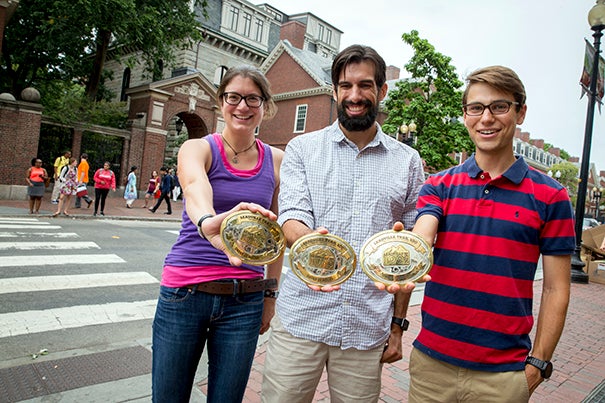
Harvard University students and training partners Maartje Bastings (left), Charles Hornbaker, and Max Darnell present their gold belt buckles for finishing the Leadville 100 Trail Run in Colorado in under 25 hours.
Rose Lincoln/Harvard Staff Photographer
Rising to the challenge
Harvard quartet push themselves to extremes in 100-mile race across mountain terrain
How far would you go for a belt buckle? Ten miles? Twenty? Does 100 sound too far? How about if you had to do it on foot? In less than 25 hours? At mountain-top elevation?
Sure, it sounds extreme, but for four Harvard students, it was an opportunity too good to pass up.
The students — Wyss Institute postdoctoral fellow Maartje Bastings; Max Darnell, a graduate student at the John A. Paulson School of Engineering and Applied Sciences; Charles Hornbaker, an M.B.A. candidate at Harvard Business School; and Kyle Pietari of Harvard Law School — were among the finishers of the famed Leadville Trail 100 Run last month, a 100-mile race through the mountains of Colorado.
The fastest of the four, Pietari, finished in second place, crossing the line in just 18:16. Hornbaker and Darnell both finished in 23-plus hours — 23:08 and 23:50, respectively —with Bastings close behind at 24:15.
For Darnell, two things attracted him to the race — the chance to push himself physically, and the opportunity to do it in one of the most beautiful settings in all of sports.
“What other experience affords you to see almost an entire mountain range in a day?” he said.
Though the classic 26.2-mile marathon hasn’t lost its status as a supreme athletic challenge, a growing number of hardcore runners have begun to turn to “ultra” marathons — including 50k, 50-mile, and even 100-mile races — as a way of pushing their bodies and minds even further.
‘You can take on a monumental task that, on the face of it, looks ridiculous and impossible, but when you break it down, it’s really just a series of small tasks.’ — Charles Hornbaker
The second-oldest 100-mile race in the United States, the Leadville 100 was created in 1983 by marathoner Ken Chlouber. It sets itself apart from most other competitions by asking runners to cover the course at an elevation of more than 10,000 feet, and to ascend beyond 17,000 — more than the elevation of Pikes Peak — twice.
Athletes who complete the race in 25 hours or less receive a gold belt buckle, along with a number of other items. Those who cross the finish line in 25 to 30 hours receive a silver buckle.
Though they admit it’s nice to have earned their buckles, it wasn’t the hardware that kept the Harvard group going.
“It’s proof you can do more than you think you can do,” Hornbaker said, when asked why he takes himself to such extremes. “For me, it applies to a lot of other areas in life — you can take on a monumental task that, on the face of it, looks ridiculous and impossible, but when you break it down, it’s really just a series of small tasks.
“For this race, it’s aid station to aid station,” he added. “I just think, all I have to do is go eight miles, when I get there I’ll get some food, and then I just have to go another seven miles to the next one … and when you get to the end of it, you look back over the whole thing, and you can say: I just accomplished something ridiculous.”
Not to mention the camaraderie involved.
“In a road marathon, people in the front aren’t saying ‘Good job’ or ‘Keep it up’ to the people in the back when they pass them,” said Darnell. “But in these races, that happens. It’s a unique environment, and the community is definitely part of it. Even in the build-up — if you sign up for a 100-mile race, you know you’re going to be running through the mountains with your friends for the next couple months to train.”
“The teamwork and camaraderie is the most important part of it,” agreed Hornbaker. “A lot of people see this as an individual sport, but it’s not — we have friends and family who act as our crew and pacers. When you come into an aid station and you see a friendly face, you don’t want to let those people down.”
Bastings, Darnell, and Hornbaker all have their sights on another 100-mile race in Virginia in just over a month, and Bastings plans to take part in an Ironman Triathlon just three weeks after that race.
In the end, Bastings said, athletes who finish a 100-mile race traverse more than just the course — the physical and mental rigors of the event make it an invaluable personal journey.
“If you do these things, you do go to a point deep within yourself,” she said. “And it’s about whether you’re willing to go there and are strong enough to really push yourself. There’s a saying: If you want to clear your mind, go for a run. If you want to distill your soul, run 100 miles.”




